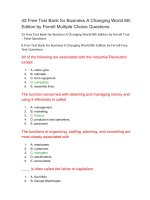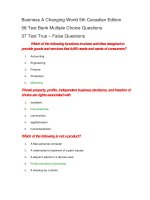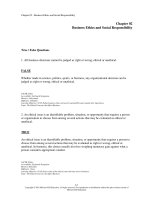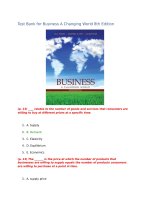Business a changing world 7e by ferrell chap014
Bạn đang xem bản rút gọn của tài liệu. Xem và tải ngay bản đầy đủ của tài liệu tại đây (1.34 MB, 39 trang )
14-1
Business in a
Changing World
Chapter 14
Accounting and Financial Statements
2
McGraw-Hill/Irwin
Copyright © 2009 by the McGraw-Hill Companies, Inc. All rights
14-3
Carlos Slim Helu – once the
richest man in the world.
Self-made man, Slim dabbles in soft drinks,
printing, and tobacco. Owns Mexico’s largest
insurance company worth $2.5 billion.
14-4
The Nature of Accounting
Accounting, defined:
The recording, measurement, and interpretation of
financial information, often used in making
business decisions.
14-5
The Nature of Accounting
GAAP – generally accepted accounting
principles.
SEC – Securities & Exchange Commission
provides oversight.
14-6
Types of Accountants
Public Accountant -- An independent professional who
provides accounting services to the public (individuals or
firms) for a fee
• CPA (Certified Public Accountant)
Private Accountant -- An accountant employed by a
corporation, government agency, or other organization
• CPA or a CMA (Certified Management Accountant)
14-7
Types of Accountants
Forensic Accountants – utilize accounting,
auditing, and investigative skills to check books of
companies.
14-8
Leading Accounting Firms
Company
2007 Revenues
($ millions)
2008 Revenues
($ millions)
“Big Four”
PricewaterhouseCoop
ers
$7,616
$25,150
Ernst & Young
$14,500
$21,000
Deloitte & Touche
$6,8750
$9,800
KPMG
$4,100
$19,800
Grant Thornton
$635
$1,075
BDO Seidman
$365
$589
McGladrey & Pullen
No data
$1,300
Second-Tier Firms
2008 Vault Accounting Firm Rankings
14-9
Types of Accountants
Sarbanes-Oxley Act – increased job prospects
for accountants and students with accounting
degrees. Higher demand for internal auditors.
14-10
Accounting - Bookkeeping
Bookkeepers -- responsible for obtaining and recording
the information that accountants require to analyze a
firm’s financial position.
Accountants -- record financial information and
understand, interpret, and develop sophisticated
accounting systems necessary to classify and analyze
complex financial information.
14-11
The Users of Accounting Information
14-12
Uses of Accounting Information
Internal uses:
– Managerial accounting
– Cash flow
– Budget
14-13
Internal Uses
Managerial accounting – internal use of accounting
statements by managers in planning & directing
the organization’s activities
Cash flow – movement of money through
organization over a daily, weekly, or monthly
basis
Budget – the internal financial plan that forecasts
expenses and income over a set period of time.
14-14
Uses of Accounting Information
External uses:
–
–
–
–
Reporting financial performance to outsiders
Filing income taxes
Obtaining credit
Reporting to stockholders
14-15
External Uses
Annual report – summary of the firm’s financial
information, products, and growth plans for
owners and investors.
Audited financial statements – annual report
signed by a CPA certifying accuracy.
14-16
External Accounting Information
Stockholders and Potential Investors
– Evaluate soundness
of investments
Government Agencies
–
–
–
–
Confirm tax liabilities
Confirm payroll
Deductions
Approve new issues of stocks and bonds
14-17
Hertz Goes Green
Hertz’ “Green Collection” of fuel-efficient
automobiles and hybrids. Helps consumers make
environmentally responsible decisions.
14-18
The Accounting Equation
The relationship between assets, liabilities, and
owners’ equity
Assets
Things of
value that
a firm
owns
=
Liabilities
A firm’s
debts and
obligations
+
Owners’ Equity
The difference
between a firm’s
assets and its
liabilities
14-19
Double-Entry Bookkeeping
A system of recording and classifying business
transactions in separate accounts in order to
maintain the balance of the accounting equation.
Assets =
Liabilities
+ Owners’ Equity
$325 = $325
14-20
The Accounting Equation and Double-Entry
Bookkeeping for Anna’s Flowers
14-21
The Accounting Cycle
1. Examining source documents
2. Recording transactions
3. Posting transactions
4. Preparing financial statements
14-22
Financial Statements
The end results of the accounting process are a series
of financial statements.
– Income statement
– Balance sheet
– Statement of cash flows
Financial statements are provided to:
–
–
–
–
Stockholders and potential investors
Creditors
Government agencies
Internal Revenue Service
14-23
GAAP
Generally Accepted Accounting Principles
(GAAP) -- Manufacturing firms, service providers, and
nonprofit organizations each use a different set of
accounting principles or rules upon which the
accounting profession has agreed.
14-24
The Income Statement
A financial report that shows an organization’s
profitability over a period of time:
– Month
– Quarter
– Year
14-25









